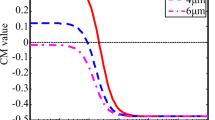Abstract
Dielectrophoresis for bio-particle manipulation has been drawing much attention in recent years. The equivalent dipole moment has been widely used to calculate dielectrophoretic forces on a particle, but this method falls short to describe the interaction between neighboring particles. The Maxwell stress tensor method (MST) is theoretically rigorous for particle interaction, but it will cost huge computing resource. In this paper, an iterative dipole moment method (IDM) is presented to investigate the interaction between multiple dielectrophoretic particles in a two-dimensional electric field. Without any cumbersome numerical computation, the inter-particle forces and the particle trajectories calculated by the IDM method are found to be in good agreement with those by the MST method for some published results. Furthermore, it is found that the final stable particle chain patterns strongly depend on the initial configuration of the particle distribution. An arbitrary small disturbance to the particle locations may lead to dramatically different motion trajectories and final particle chains.













Similar content being viewed by others
References
Ai Y, Qian S (2010) DC dielectrophoretic particle–particle interactions and their relative motions. J Colloid Interface Sci 346:448–454
Al-Jarro A, Paul J, Thomas D, Crowe J, Sawyer N, Rose F et al (2007) Direct calculation of Maxwell stress tensor for accurate trajectory prediction during DEP for 2D and 3D structures. J Phys D Appl Phys 40:71–77
Castillo J, Tanzi S, Dimaki M, Svendsen W (2008) Manipulation of self-assembly amyloid peptide nanotubes by dielectrophoresis. Electrophoresis 29:5026–5032
Çetin B, Li D (2011) Dielectrophoresis in microfluidics technology. Electrophoresis 32:2410–2427
Duchamp M, Lee K, Dwir B, Seo JW, Kapon E, Forró LS et al (2010) Controlled positioning of carbon nanotubes by dielectrophoresis: insights into the solvent and substrate role. ACS Nano 4:279–284
Gascoyne PR, Noshari J, Anderson TJ, Becker FF (2009) Isolation of rare cells from cell mixtures by dielectrophoresis. Electrophoresis 30:1388–1398
Giner V, Sancho M, Lee R, Martinez G, Pethig R (1999) Transverse dipolar chaining in binary suspensions induced by RF fields. J Phys D Appl Phys 32:1182–1186
Hossan MR, Dillon R, Roy AK, Dutta P (2013) Modeling and simulation of dielectrophoretic particle–particle interactions and assembly. J Colloid Interface Sci 394:619–629
House DL, Luo H, Chang S (2012) Numerical study on dielectrophoretic chaining of two ellipsoidal particles. J Colloid Interface Sci 374:141–149
Hughes MP (2002) Strategies for dielectrophoretic separation in laboratory-on-a-chip systems. Electrophoresis 23:2569–2582
Kang KH, Li D (2006) Dielectric force and relative motion between two spherical particles in electrophoresis. Langmuir 22:1602–1608
Kang S, Maniyeri R (2012) Dielectrophoretic motions of multiple particles and their analogy with the magnetophoretic counterparts. J Mech Sci Technol 26:3503–3513
Kurgan E (2011) Stress calculation in two-dimensional DC dielectrophoresis. Prz Elektrotech 87:107–110
Kurgan E (2012) Comparison of different force calculation methods in DC dielectrophoresis. Prz Elektrotech 88:11–14
Kurgan E (2013) Influence of numerical method on computational accuracy in DC dielectrophoresis. Przegląd Elektrotechniczny. 89:71–74
La Magna A, Camarda M, Deretzis I, Fisicaro G, Coffa S (2012) Coupled Monte Carlo–Poisson method for the simulation of particle–particle effects in dielectrophoretic devices. Appl Phys Lett 100:134104
Moncada-Hernandez H, Nagler E, Minerick AR (2014) Theoretical and experimental examination of particle–particle interaction effects on induced dipole moments and dielectrophoretic responses of multiple particle chains. Electrophoresis 35:1803–1813
Morgan H, Green NG (2003) AC electrokinetics: colloids and nanoparticles. Research Studies Press Ltd., Baldock, Hertfordshire
Morgan H, Hughes MP, Green NG (1999) Separation of submicron bioparticles by dielectrophoresis. Biophys J 77:516–525
Nakajima Y, Sato T (1999) Calculation of electrostatic force between two charged dielectric spheres by the re-expansion method. J Electrostat 45:213–226
Pohl HA (1978) Dielectrophoresis: the behavior of neutral matter in nonuniform electric fields. Cambridge University Press, Cambridge
Rosales C, Lim KM (2005) Numerical comparison between Maxwell stress method and equivalent multipole approach for calculation of the dielectrophoretic force in single-cell traps. Electrophoresis 26:2057–2065
Wang X, Wang X-B, Gascoyne PR (1997) General expressions for dielectrophoretic force and electrorotational torque derived using the Maxwell stress tensor method. J Electrostat 39:277–295
Washizu M, Jones T (1994) Multipolar dielectrophoretic force calculation. J Electrostat 33:187–198
Washizu M, Jones TB (1996) Dielectrophoretic interaction of two spherical particles calculated by equivalent multipole-moment method. Ind Appl IEEE Trans on 32:233–242
Washizu M, KVIS K (1993) Higher-order dielectrophoretic effects: levitation at a field null. Biochim et Biophy Acta (BBA)-Gen Subj 1158:40–46
Author information
Authors and Affiliations
Corresponding author
Additional information
Supported by National Science Foundation of China, No. 11172111.
Rights and permissions
About this article
Cite this article
Liu, L., Xie, C., Chen, B. et al. A new method for the interaction between multiple DEP particles: iterative dipole moment method. Microsyst Technol 22, 2223–2232 (2016). https://doi.org/10.1007/s00542-015-2624-2
Received:
Accepted:
Published:
Issue Date:
DOI: https://doi.org/10.1007/s00542-015-2624-2



